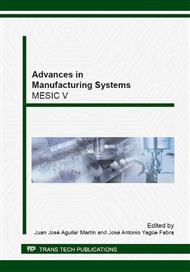p.3
p.9
p.15
p.22
p.32
p.39
p.45
p.51
Accuracy Analysis of Fringe Projection Systems Based on Blue Light Technology
Abstract:
Some manufacturers of 3D digitizing systems are developing and market more accurate, fastest and affordable systems of fringe projection based on blue light technology. The aim of the present work is the determination of the quality and accuracy of the data provided by the LED structured light scanner Comet L3D (Steinbichler). The quality and accuracy of the cloud of points produced by the scanner is determined by measuring a number of gauge blocks of different sizes. The accuracy range of the scanner has been established through multiple digitizations showing the dependence on different factors such as the characteristics of the object and scanning procedure. Although many factors influence, accuracies announced by manufacturer have been achieved under optimal conditions and it has been noted that the quality of the point clouds (density, noise, dispersion of points) provided by this system is higher than that obtained with laser technology devices.
Info:
Periodical:
Pages:
9-14
Citation:
Online since:
June 2014
Keywords:
Price:
Сopyright:
© 2014 Trans Tech Publications Ltd. All Rights Reserved
Share:
Citation:


